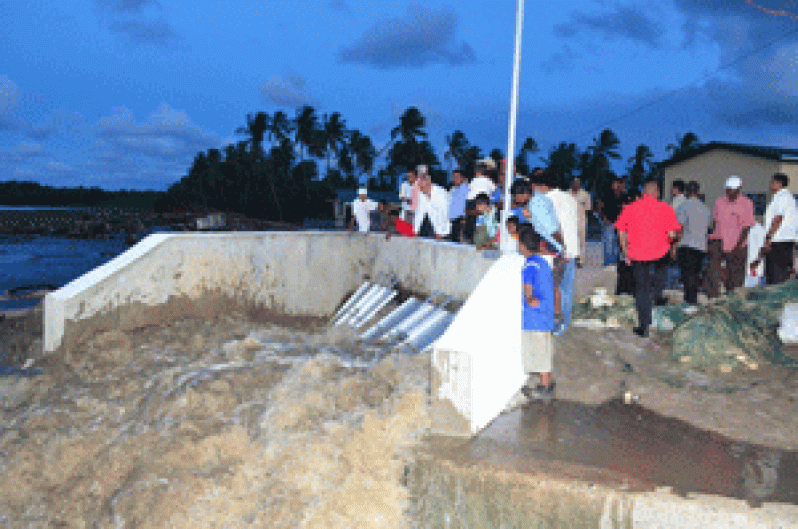ANOTHER major drainage and irrigation facility, the Greenfield drainage pump station, which was built at the cost of over $200M, and which will help drain approximately 3,000 acres of residential and farm lands, was Thursday commissioned by President Donald Ramotar.
 In an overview of the project, Chief Executive Officer of the National Drainage and Irrigation Authority (NDIA), Lionel Wordsworth, said that in 2005-2006, it was discovered that the existing sluice was showing signs of deterioration.
In an overview of the project, Chief Executive Officer of the National Drainage and Irrigation Authority (NDIA), Lionel Wordsworth, said that in 2005-2006, it was discovered that the existing sluice was showing signs of deterioration.
However, the project came into being in 2009, subsequent to a visit to the areas by former President, Bharrat Jagdeo. The contract, which was signed in September 2009 was awarded to Harrychand Tulsi.
President Ramotar said that drainage pump stations are essential to ensuring the nation’s food security which is of extreme importance, especially in light of the significant growth in world population to seven billion. For this reason, many developed countries have been moving into Third World countries to acquire large tracts of land, fundamentally to secure their own food supply.
Guyana on the other hand, has an ideal opportunity to develop its agriculture base and ensure its own food security, as well as that of the region.
However, the country still imports about US $3B -$4B worth of food every year, which can be reduced, given the fact that it has the capacity to produce enough food. Some of the main factors in achieving this objective includes arable land and fresh water, which are abundantly available, and effective D&I systems, especially in communities that depend heavily on farming.
Government has been investing heavily in physical infrastructure throughout the length and breadth of the country, as it shares the view that this is the foundation for faster development. Since 1992, billions of dollars have been spent to improve D&I structures, particularly in vulnerable areas, to boost agriculture and in so doing, improve the living standards of many.
Pump stations have been rehabilitated in Stanleytown, Region 3 and Liliendaal and Kitty, Region 4.
Additionally, under the Agriculture Support Services Programme, pumps stations have been rehabilitated at Victoria and Cane Grove and new pumps were installed at Lusignan, Region 4 and at Number 19 and 42 Villages in Region 6. Meanwhile, pumps were rehabilitated at Trafalgar, Region 5, and Anna Regina and Cozier in Region 2.
Moreover, as Guyana continues to increase its pumping capacity on the coast land, other pump stations and sluices will soon be built at Canals Polder, Region 3 and Black Bush Polder, Region 6.
“In another year’s time, we will probably have an additional 14 sluices and pumps installed on the coastland as we try to have the right conditions for the development of our agriculture,” President Ramotar said.
He also called on citizens to take a personal interest to ensure that these structures function effectively so that, as the primary beneficiaries, they can derive optimum benefits. He also lamented the irresponsible dumping of garbage in drains and other waterways, which contributes to flooding.
Minister of Agriculture, Dr. Leslie Ramsammy, in his remarks, said that given the inevitability of climate change, systems have to be put in place to mitigate the devastating effects of flood and drought.
He also spoke of the move by the Parliamentary Opposition to vote against the funds under the Guyana REDD+ Investment Fund (GRIF) programme which included $420M for the reconstruction of the Cunha Canal, which would help to keep the East Demerara Water Conservancy (EDWC) safe, bringing much needed relief to residents at Mahaica, Mahaicony and Abary.
Nevertheless, he disclosed that government will be moving ahead with the project with funds from the Guyana-Norway agreement, which have already been deposited in the World Bank account.
At present, World Bank officials are in Guyana and are consulting with officials from the NDIA to finalise the design and other aspects of the project.
Meanwhile, Minister within the Ministry of Agriculture, Ali Baksh, spoke of the many initiatives, including a wider spectrum of markets, that farmers today have at their disposal.
The Greenfield pump station will be operated at a combined discharge capacity of 300-cubic feet per second, and will be managed by the NDIA to serve the areas extending from Unity and Hope Estate in the East, and Crown Dam in the south.
It forms part of the 2012 programme as well as the wider NDIA master plan.
Head of State commissions new $200M Greenfield pump station -another initiative towards ensuring food security
SHARE THIS ARTICLE :
Facebook
Twitter
WhatsApp



.jpg)








